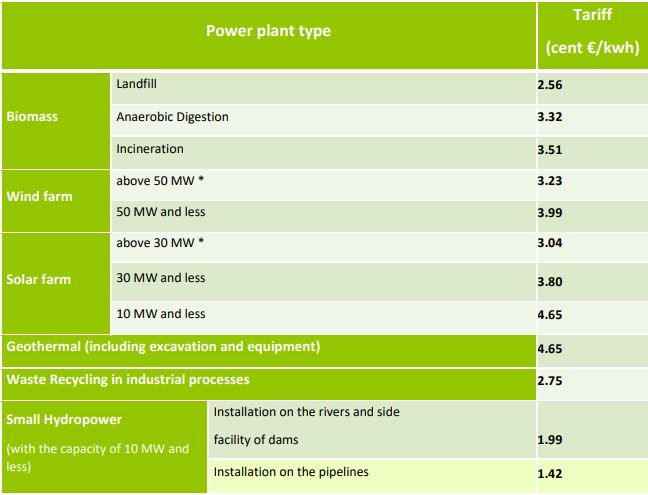RE in Iran
Iran has a vast potential for renewable energy, wind and solar energy resources are the best among other renewable energy resources in the region.
Following the increasing power demand, fuel subsidies decreasing and a need for much greater energy security, the Iranian government and policy makers are showing a significant interest in the renewable energy field. One of the most important steps in this direction was setting a 10-GW target for installed capacity from renewables by 2024. Feed-in tariffs are also another incentive policies that SATBA, the country’s renewable energy organization, has established which guarantee a 20-year power purchase payment.
Solar Energy
Iran has huge solar PV potential with an average solar radiation of 4.5-5.5 kWh/m2 and up to 300 sunny days a year over 2/3 of its total area. The regions of highest concentration of irradiation are the central and southern areas.
Iran is located on the Solar Belt and is among the states which enjoy a high solar potential and is considered as one of the proper places for utilisation of solar energy. Of other elements justifying feasibility of these systems in our country we can refer to availability of rich silicone mines in 90% of the lands as the raw material for production of photovoltaic cells, availability of vast unused areas for installation of solar systems, possibility of gradual replacement of fossil fuel power plants with solar systems in order to use fossil fuels for added value applications, increasing energy security, positively affecting the employment issue especially for educated workforce, being harmless to the environment and capability of sustained development, profitability for national economy, capacity of distributed generation and less dependency on nationwide grid. From technical point of view, photovoltaic systems have unique advantages such as possibility of installation in any location and compatibility with topology of installation sites, probability of generation in place of consumption and independence from transmission and distribution systems, production without requirement of fuel and its costs, variable output in accordance with requirements of the consumer, capability of storage and eventually ease of installation, operation and maintenance.
 The annual average on solar irradiation in Iran, period 1999-2015
The annual average on solar irradiation in Iran, period 1999-2015
Wind Energy
Iran has over 100,000MW of potential installed capacity of wind power to tap into. With electricity demand rising and Iran possessing excellent topography and geography for wind power the Iranian government have made it their top priority over other renewable energy sources. Roughly 4,500 MW of the proposed 5,000 MW increase in capacity of renewable is expected to come from utility-scale wind farms throughout the country.
Due to its strategic location along several major wind corridors, Iran’s northwest and northeast regions experience high winds all year. The consistency of these wind currents allows for sustainable access to wind energy.
Iran is well-positioned to rapidly scale up its wind power sector. The country already operates 15 wind farms and the vast majority of the components used to develop those farms were produced locally. Iran has made use of its abundant human capital to develop technological capabilities in turbine, generator, and inverter production.

Renewable Energy Power Plants
The current total installed power capacity of Iran is 77GW, the government plans to increase this to over 100GW in the next few years. Currently, power generated from renewable sources makes up less than 1% of this, with gas-fired combined cycle and steam plants making up the largest proportion of the energy mix. Electricity consumption has grown steadily in Iran over the last decade with an average year-on-year percentage increase of over 7%. The industrial sector is the largest electricity consumer with 34.6% share, followed by residential (31.7%), agricultural (16.3%), public services (8.8%) and the commercial sector (6.6%). Some sources are predicting that, with a return to the international markets and an increase in manufacturing and construction, overall consumption could reach 444000 GWh by 2030.
As you can see in the table below, the maximum capacity of installed renewable energy powerplants is belonged to Solar (PV) power plants with 309 MW capacity. The second position is for the Wind energy power plants with 285 MW capacity.
 Installed renewable energy power plants situation up to end of April, 2019 in Iran
Installed renewable energy power plants situation up to end of April, 2019 in Iran

Following the 5-GW target to install renewable energy power plants by 2020, many companies have started installing procedure. Fortunately more than 4 GW PPA has been issued to install renewable energy power plants in Iran. Nearly 3 GW of that is belonged to solar power plants. Only one year is remained to implement the 5-GW target, so it can be a wonderful opportunity for investors to invest on and make an outstanding business. As it is mentioned above, the incentive policies and the attracting feed in tariffs are suitable parameters to consider investing on renewable energy in Iran. The number of companies who have obtained PPA is shown in the table below with their capacity.
 Companies with renewable & clean power purchase agreement (PPA) up to end of April, 2019 in Iran
Companies with renewable & clean power purchase agreement (PPA) up to end of April, 2019 in Iran
On the implementation of the legal obligations of Iran’s ministry of energy, the guaranteed electricity purchase feed-in tariff for types of renewable and clean energy are notified as follows:

